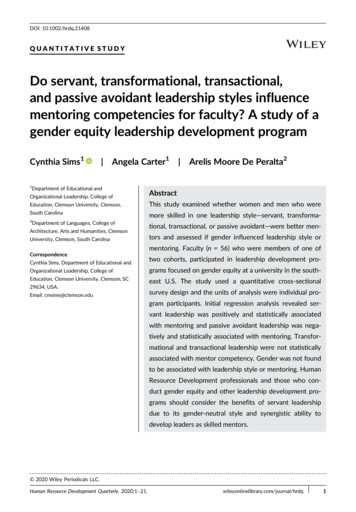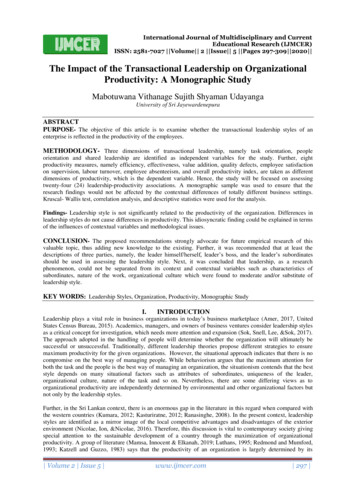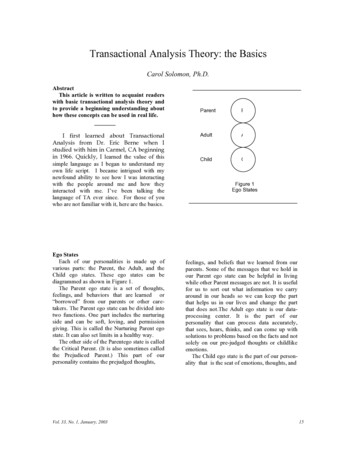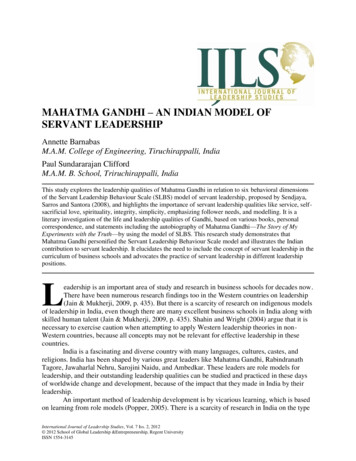
Transcription
DOI: 10.1002/hrdq.21408QUANTITATIVE STUDYDo servant, transformational, transactional,and passive avoidant leadership styles influencementoring competencies for faculty? A study of agender equity leadership development programCynthia Sims11 Angela Carter1 Department of Educational andArelis Moore De Peralta2Organizational Leadership, College ofAbstractEducation, Clemson University, Clemson,This study examined whether women and men who wereSouth Carolinamore skilled in one leadership style—servant, transforma-2Department of Languages, College ofArchitecture, Arts and Humanities, ClemsonUniversity, Clemson, South Carolinational, transactional, or passive avoidant—were better mentors and assessed if gender influenced leadership style ormentoring. Faculty (n 56) who were members of one ofCorrespondenceCynthia Sims, Department of Educational andtwo cohorts, participated in leadership development pro-Organizational Leadership, College ofgrams focused on gender equity at a university in the south-Education, Clemson University, Clemson, SCeast U.S. The study used a quantitative cross-sectional29634, USA.Email: cmsims@clemson.edusurvey design and the units of analysis were individual program participants. Initial regression analysis revealed servant leadership was positively and statistically associatedwith mentoring and passive avoidant leadership was negatively and statistically associated with mentoring. Transformational and transactional leadership were not statisticallyassociated with mentor competency. Gender was not foundto be associated with leadership style or mentoring. HumanResource Development professionals and those who conduct gender equity and other leadership development programs should consider the benefits of servant leadershipdue to its gender-neutral style and synergistic ability todevelop leaders as skilled mentors. 2020 Wiley Periodicals LLC.Human Resource Development Quarterly. 2020;1–21.wileyonlinelibrary.com/journal/hrdq1
2SIMS ET AL.KEYWORDSgender, higher education, leadership development, mentoring,passive avoidant transactional, servant leadership, STEM,transformational1I N T RO DU CT I O N In higher education, it is well documented that women hold fewer leadership positions than men (Cook, 2012; Eagly& Carli, 2007; Richardson & Loubier, 2008; Ryan & Haslam, 2007). This marked lack of leadership diversity in theacademy (Johnson, 2016) is particularly salient in science, technology, engineering, and mathematics (STEM) disciplines (Levine, González-Fernández, Bodurtha, Skarupski, & Fivush, 2015; N. Thomas, Bystydzienski, & Desai, 2015).To reverse this trend, the U.S. National Science Foundation (NSF) ADVANCE program works with higher education“to increase the representation and advancement of women in academic science and engineering careers, therebydeveloping a more diverse science and engineering workforce” (2009, p. 2). For their part, higher education institutions determined that leadership development and mentoring are necessary, useful, and effective tools to preparewomen for future administrative roles and responsibilities (Madsen, 2011).When planning a leadership development program, practitioners, and scholars are tasked with determining whatleadership style(s) should be taught. The style a leader adopts may be informed by theory (Bass & Bass, 2008;Northouse, 2018). Leadership styles differ by goal and purpose, for example, servant focuses on personal development, transformational elicits performance, transactional drives productivity, and passive avoidant intervenes to correct mistakes and punish noncompliance (Avolio & Bass, 2000; Bass, 1985; Burns, 1978; Greenleaf, 1970). Whenemployed, these theories are reflected in the leaders' day-to-day practices. As the ability to mentor others is frequently a desired outcome of leadership development programs, program administrators are likely to assess theimpact of leadership style on mentoring ability. The literature on leadership development of STEM faculty discussesdeveloping leadership skills in general; however, there is limited specific documentation or recommendations onwhat leadership style(s) directly benefit both women and men in higher education gender equity leadership programs(DeFrank-Cole, Latimer, Neidermeyer, & Wheatly, 2016; Laursen & Rocque, 2009; Levine et al., 2015; Margherio,Horner-Devine, Mizumori, & Yen, 2016; O'Bannon, Garavalia, Renz, & McCarther, 2010; Richman, Morahan, Cohen,& McDade, 2001). In brief, we asked whether women and men who were more proficient in one leadership stylewould be more skilled mentors than those who enacted different styles.22.1LITERATURE REVIEW Leader and leadership developmentOrganizations use a variety of Human Resource Development (HRD) approaches to invest and build organizational capacity. Over time, leader and leadership development has become central to the field of HRD and is considered a critical undertaking of HRD professionals (Ardichvili, Natt och Dag, & Manderscheid, 2016; Callahan,Whitener, & Sandlin, 2007; Madsen, 2011). Although there are many definitions of leadership, we useYukl's (2006), which says that “leadership is the process of influencing others to understand and agree aboutwhat needs to be done and how to do it, and the process of facilitating individual and collective efforts toaccomplish shared objectives” (p. 3). As a skill, organizations seek to increase individuals' leadership capacity byproviding developmental experiences. The focus of these learning experiences is leader development—increasingan individual's intrapersonal competencies, self-awareness, self-regulation, self-motivation, and leader identity, to
3SIMS ET AL.enhance their leadership performance across roles (Ardichvili et al., 2016; Day, 2000; Gardner, Avolio, Luthans,May, & Walumbwa, 2005).As individuals learn about different leadership theories, they can begin to align their behaviors accordingly andreap the benefits associated with enacting specific leadership styles (Barbuto Jr. & Wheeler, 2006; Bass &Bass, 2008; Day, 2000). Leadership style is described as the actions or behaviors deployed by an individual whoseeks to influence other's behavior to achieve a goal (Bass & Bass, 2008). While leader development focuses onintrapersonal competencies or human capital, leadership development concentrates on how to build interpersonalcompetencies or social capital (Day, 2000; Day, Fleenor, Atwater, Sturm, & McKee, 2014). Individuals need to buildtheir social awareness and social skills and use interpersonal competencies to differentiate and integrate appropriateleadership behavior for the social context in which they might find themselves (Day, 2000). Both leader and leadership development are complementary and necessary, as individuals need to develop their leader competencies andapply them in the social context if their leadership is to be realized (Collins & Holton, 2004; Day, 2001; Dayet al., 2014). From an HRD perspective, leader and leadership development are developmental processes, whichrequire continual learning (Ardichvili et al., 2016; Day, Harrison, & Halpin, 2009).2.2Leadership styles While there are many leadership styles, a focus on transformational, transactional, passive avoidant, and servantleadership styles is particularly germane. These styles stand out; transformational leadership is preeminent and suchleaders apply vision, strategy, and ethics; transactional leadership has a long history and helps ensure work gets donein organizations; and passive avoidant is the antithesis of leadership and should be avoided (Bass & Bass, 2008). Servant leadership is a modern style, which focuses on people first, and being a positive force within and outside of theorganization (Barbuto Jr. & Wheeler, 2006; Greenleaf, 1970).2.2.1 Leadership continuumBurns (1978) conceptualized and distinguished between two leadership styles: transactional (exchanges that occurbetween leaders and associates) and transformational (the process whereby a person engages with others and creates a connection that raises the level of motivation and morality in both leader and the associate). Bass evolved thetheory and specified transformational leadership occurs when “[T]he leader elevates the follower morally about whatis important, valued, and goes beyond the simpler transactional relationship of providing reward or avoidance of punishment for compliance” (Bass & Bass, 2008, p. 1217). Avolio and Bass (2000) described a continuum of leadershipactivity that is anchored on the left by passive avoidant or non-leadership, connected in the middle by transactionalor reinforcement leadership, and anchored on the right by transformational or motivational leadership. Transformational leaders set goals with a higher purpose and motivate followers to transcend self-interest to achieve outcomesthat meet or exceed expectations while enhancing the follower's self-worth (Bass & Bass, 2008).Transformational leadership consists of idealized influence (be ethical, serve as role models, and inspire followersto identify with and emulate the leader), inspirational motivation (using motivation, followers are inspired to committo the leader's vision and go beyond self-interest), intellectual stimulation (challenge the status quo, innovate, andproblem-solve to achieve the leader's vision), and individualized consideration (provide a supportive environment tomeet each employee's unique needs while furthering their growth and development) (Bass & Bass, 2008). Idealizedinfluence and individualized consideration are consistent with the relational competencies associated with leadershipdevelopment (Bass, 1985).From a developmental perspective, Bass (1985) indicated that transformational leaders mentor others. As atransformational leader, the individual comes to recognize that when they serve as a role model, share an
4SIMS ET AL.inspirational vision, ask followers to think outside of the box, and meet the unique developmental needs of theiremployees, they are, respectively, using idealized influence, inspirational motivation, intellectual stimulation, and individualized consideration, which are directly transferrable to mentoring (Chun, Sosik, & Yun, 2012; Day et al., 2009).As individuals build their transformational leadership competencies, they may use these behaviors in their mentoringrepertoire to provide psychosocial and career support (Chun et al., 2012).Transactional leaders are likely to be successful mentors. As part of the contingent reward (CR), leaders set goals,help employees develop the competencies for goal achievement, and set rewards (Sosik & Godshalk, 2000). Whenmentors establish learning contracts with their protégés, mentors initiate support and direct the pair's activities tofulfill the contract and reward the protégé as they succeed (Sosik & Godshalk, 2000). These actions likely facilitatethe career development of the protégé, builds trust between the mentor and protégé, increases the protégé's job satisfaction, all of which are ways mentors provide psychosocial support to their protégés (Sosik & Godshalk, 2000).Although transactional behavior supports aspects of the mentoring relationship, it is a poor replacement for transformational leadership and likely results in weaker mentoring relationships (Sosik & Godshalk, 2000).Passive avoidant leadership is characterized by punishments and avoidant behaviors as it “strives to maintain thestatus quo through delay, absence and indifference” (Sosik & Godshalk, 2000, p. 372). As mentoring is based on apositive relationship where the mentor actively seeks positive career and developmental opportunities for theirprotégés, acts as a positive role model, and provides psychosocial support, there will likely be a negative relationshipbetween passive avoidant leadership and mentoring (Banerjee-Batist, Reio Jr, & Rocco, 2019; Day, 2000; Noe, 1988;Sosik & Godshalk, 2000; Yukl, 1994). The passive avoidant leader shirks their responsibility and is indifferent towardtheir subordinates, this leadership style is in stark contrast to servant leadership, which we discuss next (Bass &Bass, 2008).2.2.2 Servant leadershipWhen launching an institution, a servant leader “starts on a course toward people-building with leadership that hasa firmly established context of people first. With that, the right actions fall naturally into place” (Greenleaf, 1970, p.31). Over time, theorists built upon Greenleaf's (1970) conceptualization of servant leadership (Eva, Robin,Sendjaya, van Dierendonck, & Liden, 2019). Barbuto Jr. and Wheeler (2006) theorized servant leadership to includealtruistic calling (a fundamental personal desire to serve others and meet their needs), emotional healing (use ofempathy and listening to help others heal from hardship or trauma, and create an environment where employeesfeel safe to speak), wisdom (ability to see and interpret environmental cues and anticipate what is to come), persuasive mapping (provide a compelling vision of the future based on reason and inspire other to support it), andorganizational stewardship (a desire to leave a positive legacy in the organization and society). Together these constructs manifest when servant leaders facilitate the personal and professional growth of others by meeting theirprofessional development and organizational needs. Thus, they ensure “followers develop in a positive direction”(Barbuto & Wheeler, 2006, p. 308). Due to the developmental focus of servant leadership, such leaders are likelyto be good mentors.Several studies address servant leadership and mentoring: Steinbeck's (2009) determined a moderately strongpositive relationship between mentors' behavior and effectiveness; Paul and Fitzpatrick (2015) revealed servant leadership predicted student-advising satisfaction; and Jackson (2009) discovered that writing mentors applied servantleadership to their clients. Mentors with greater learning goal orientation and servant leadership were found to provide their protégés with better role modeling, career development, and psychosocial support (Egan, 2005; Godshalk& Sosik, 2000). Further, those with servant leadership behaviors may be more receptive to training and development,likely to evolve their mentoring schemas and become more effective mentors over time (Banerjee-Batist et al., 2019).This research suggests that as individuals grow as servant leaders, their skills in identifying and meeting others' needsincrease, and these leaders will demonstrate the interpersonal relational skills necessary of mentors to meet the
5SIMS ET AL.career and psychosocial needs of their protégés (Allen, Eby, & Lentz, 2006; Jackson, 2009; Paul & Fitzpatrick, 2015;Steinbeck, 2009).Both servant leadership and transformational leadership “emphasize the importance of appreciating and valuingpeople, listening, mentoring or teaching and empowering followers”; yet these leadership styles are distinct (BarbutoJr. & Wheeler, 2006; Stone, Russell, & Patterson, 2004, p. 354). Servant leaders concentrate on serving followers'needs, cultivating their relationship with others, and trusting their followers to act in the best interest of the organization (Sims & Morris, 2018; Stone et al., 2004). As compared to transformational leaders who motivate followers tomeet organizational goals (Barbuto Jr. & Wheeler, 2006).2.3 Leadership development and mentoringMentoring style “refers to the [observable] behaviors or strategies that mentors employ” and will change over timebased upon mentoring and other experiences (Nyanjom, 2020, p. 250). Mentoring is an effective leadership development strategy, occurs in a context, and enhances protégés' intrapersonal and interpersonal competencies (Day, 2000).As leadership and mentoring are participatory practices, what leadership behaviors individuals enact will influencetheir mentoring competencies (Day, 2000). We theorize that the intrapersonal style of the leader will influence theinterpersonal relational skills they use when mentoring. Moreover, the quality of mentoring will differ based on theleadership lens or style used by the mentor. The limited research on this topic indicates that through mentoring,mentors increase their personal development as leaders (Banerjee-Batist et al., 2019; Eby, Durley, Evans, &Ragins, 2006; Ghosh & Reio, 2013). Employing transformational leadership behavior positively relates to both mentors' and protégés' career development, role modeling, psychosocial support, and effectiveness and/or job satisfaction (Chun et al., 2012; Godshalk & Sosik, 2000; Scandura & Williams, 2004; Sosik & Godshalk, 2000). There islimited research that directly links leadership style to mentoring ability within individuals.Mentoring may be a one-on-one relationship where someone in a more senior role provides guidance to someone less experienced. This traditionally paired relationship is called hierarchical mentoring and occurs within organizations where typically, both mentors and protégés benefit from mentoring (Banerjee-Batist et al., 2019; Ghosh &Reio, 2013). Mentoring is associated with increased job satisfaction, organizational commitment, and employeeretention and conversely, turnover intention (Aremu & Adeyoju, 2003; Germain, 2011; Stallworth, 2003; Walsh,Borkowski, & Reuben, 1999). Mentors were likely to experience increased recognition, job performance, job satisfaction, and leadership skill (Chun et al., 2012; Ghosh & Reio, 2013). When mentors act as coaches, counselors, rolemodels, and confidants they provide their protégé with psychosocial support and the protégé reap the benefits oftheir mentor's sponsorship and guidance on how to navigate their organizational career successfully (Banerjee-Batistet al., 2019; Sosik & Godshalk, 2000). When the mentor is considered a role model, the protégé benefits from greaterconfidence, self-efficacy, and job performance (Dickson et al., 2014). Furthermore, the ability to mentor can belearned and encouraged (Banerjee-Batist et al., 2019).Research to determine the effects of synergy among leadership styles on mentor effectiveness is one aspect thathas been neglected (Banerjee-Batist et al., 2019; Godshalk & Sosik, 2000; Kim, 2007). As mentoring is pivotal tocareer success, HRD professionals concern themselves with the design and conduct of mentoring programs to meetindividual and organizational needs (Banerjee-Batist et al., 2019; Hezlett & Gibson, 2005). Organizations use mentoring programs to onboard and develop employees (Banerjee-Batist et al., 2019). Mentoring is also a tool used tosupport leaders and leadership development (Chun et al., 2012; Day, 2001; Poon, 2006). Further, organizations arewell served to select and groom mentors who possess the leadership styles necessary to be successful mentors. Asindividuals grow their interpersonal leadership skills, over time their mentoring skills, schema, and style will expand(Banerjee-Batist et al., 2013; Nyanjom, 2020). Individuals' mentor style will reflect their identities, including theirleader, gender, and mentor identities (Nyanjom, 2020). More research is needed to address the confluence of leadership, mentoring, and leadership.
6SIMS ET AL.2.3.1 Gender, mentoring, and higher educationResearch indicates that when mentored, women leaders were more likely to have expanded networks, experiencedgreater career planning, and consider themselves better leaders (Dickson et al., 2014). Formal mentoring programsare important for women because they may experience more institutional barriers to establishing informal relationships than their male counterparts (Dickson et al., 2014). To be effective, mentors need skills to successfully navigategender and cultural differences, orient protégé's to the organization, and transfer their competencies (Chesler &Chesler, 2002).As higher education continues to experience extraordinary challenges, leaders with exceptional skills to ensureorganizations succeed are needed at the top and all leadership levels (Rubin, 2004). One reason there is a lack ofleaders, Madsen (2011) argues, is there are “fewer women positioned to take on such critical roles” (p. 4). Organizations that desire to advance change and establish an effective leadership cadre should encourage leadership development practices like mentoring, as it is considered an effective tool (Bonebright, Cottledge, & Lonnquist, 2012;Madsen, 2011; White, 2012). Although leadership development programs for women in higher education haveexisted for decades, scholarly research is limited and much needed to provide guidance on leadership interventions,including mentoring that can develop women's leadership skills (Madsen, 2011).2.3.2 Gender, mentoring, and leadershipMentoring is offered and employed as one career development strategy to help address the inequity of women notprogressing in their careers, proportionally to their participation in the labor force (Banerjee-Batist et al., 2019; Eagly& Carli, 2007). Abundant research exists on gender and mentoring and includes the examination of the difficultiesassociated with cross-gender mentoring and the value organizations often place on having more masculine versusfeminine cultures (Banerjee-Batist et al., 2019; Ensher & Murphy, 2011). Unlike men in higher education, women faculty were more likely to be in mentoring relationships and provide more mentoring due to the gender-based expectations of their students (Banerjee-Batist et al., 2019; Griffin & Reddick, 2011; J. W. Smith, Smith, & Markham, 2000).Women faculty encountered more challenges in mentoring male protégés (Banerjee-Batist et al., 2019; K. M.Thomas, Willis, & Davis, 2007). Nonetheless, the male and female role expectations associated with mentoring didnot differ by gender (Banerjee-Batist et al., 2019; Walsh et al., 1999).The research found women who were mentored enjoy more organizational success (Ragins, Townsend, &Mattis, 1998; Wanberg, Welsh, & Hezlett, 2003). O'brien, Biga, Kessler, and Allen's (2010) meta-analysis determinedwomen and men were just as likely to report that they were a protégé and receive similar career development opportunities. As mentors, women provided more psychosocial support than men did; while male mentors provide morecareer development support than female mentors do (O'Brien et al., 2010).Just as gender was found to be differentiating within mentoring experiences, gender may influence leadership.Leadership was historically conceptualized and studied more with a masculine lens (Bierema & Callahan, 2014;Kark, 2004; Koenig, Eagly, Mitchell, & Ristikari, 2011). Gender research found women and men displayed differentlevels of transformational leadership (Eagly, Johannesen-Schmidt, & Van Engen, 2003). Earlier meta-analyses (Eagly& Carli, 2003) indicated women demonstrated a more democratic (or participative) style and less autocratic (or directive) style than men in relationship to the exercise of power. When compared to men, women leaders were moretransformational and used CR systems (Eagly & Carli, 2003). These behavioral differences were small but consistent.Leader gender differences may vary based on the woman's racial identity (Sims & Carter, 2019).Turning to servant leadership and gender, Barbuto and Gifford (2010) determined women and men exhibitedleadership behaviors that were communal and agentic. These findings contradicted prior research, which foundwomen and men displayed different levels of transformational and authentic leadership (Eagly & Carli, 2003; Sims,Gong, & Hughes, 2017). Hogue (2016) suggested women benefit from the communal aspects of servant leadership
7SIMS ET AL.because there is more congruency between being a woman and a servant leader than a woman and other types ofnon-communal leadership styles. Servant leadership may be unique among leadership styles because it enables“leaders to step out of gender role norms and provide the most appropriate leadership for followers” (Barbuto &Gifford, 2010, p. 16; Sims & Morris, 2018). Relative to gender and servant leadership, no support was found thatwomen and men display different levels of servant leadership, which affirms the notion servant leadership is a gender-neutral set of leader behaviors (Barbuto & Gifford, 2010; Sims & Morris, 2018).A meta-analysis on gender differences and leadership effectiveness had several transformational leadershipstudies but none on servant leadership or mentoring (Paustian-Underdahl, Walker, & Woehr, 2014). The meta-analysis suggested several factors moderate the relationship between gender and leadership on whether the rating wasonce done by self or other raters, organization type, the level of the leader, and the study setting (Paustian-Underdahl et al., 2014). The study concluded when rated by others, women were considered more effective leaders inbusiness and education organizations and more effective in middle management and senior roles while men wereperceived as more effective in male-dominated organizations. As self-raters, men considered themselves more effective leaders than women in lower and senior managerial levels. In searching for literature that addressed gender,mentoring, and leadership, no studies were found that addressed the interaction of these constructs.Based on the literature, the following hypotheses are proposed:Hypothesis 1. Transformational leadership style is positively and statistically associated with mentoring competency.Hypothesis 2. Transactional leadership style is positively and statistically associated with mentoring competency.Hypothesis 3. Passive avoidant leadership style is negatively and statistically associated with mentoring competency.Hypothesis 4. Servant leadership style is positively and statistically associated with mentoring competency.Hypothesis 5. Servant leadership style has a stronger positive association with mentoring competency than transformational leadership style.Hypothesis 6. Mentoring competency levels and leadership styles will vary by gender.3METHODS This study used a quantitative cross-sectional design using survey methodology incorporating several measurementinstruments. Leadership development participants were the individual units of analysis. This study relies on participants' self-ratings, as it is difficult to collect rater feedback on emerging leaders and mentors when they do not haveindividuals whom they lead or mentor. To reduce common method bias, this study used longer scales to reduce thelikelihood of one survey influencing another, intermixed different variables of mentoring and leadership in one survey, did not reveal that independent variables (leadership) were related to the outcome variable (mentoring), and collected independent variables at separate times using different survey administration tools (Podsakoff, MacKenzie,Lee, & Podsakoff, 2003).3.1 Participant sampleThere were two cohorts of participants. The 28 participants in the 2017 cohort were majority women (71%), White(79%), more than half (57%) were between 40 to 49 years of age, almost half (43%) were associate professors, and
8SIMS ET AL.25% held the professor rank. At the time of the survey, participants reported having leadership (39%) and mentoring(57%) experience. The 2018 cohort participants (n 28) were also primarily female (71%), White (73%), with (23%)Asian representation, and no self-identified Hispanics. In both cohorts, there was only one participant self-identifiedas Black. In the 2018 cohort, about one-third (36%) were associate professors, and there were more tenure trackprofessors (32%) compared with the 2017 cohort (18%). They reported having leadership (45%) and mentoring (36%)experience.3.2 Survey proceduresThe research team informed program participants of the research study in the program invitation and during face-toface program sessions. An informed consent form, approved by the university's institutional review board introducedthe survey. Using participants' email addresses, cohort members received an email inviting them to complete thesurvey.The web survey tool Qualtrics was used to create a questionnaire that included demographic questions and twoinstruments: mentoring competency assessment (MCA) and servant leadership. The vendor web survey tool MindGarden was used to administer the transformational, transactional, and passive avoidant leadership instrument. Inyear one, participants received links at the same time in the fall, September to November, to complete the Qualtricsand MindGarden surveys. In year two, based on feedback from first-year participants, participants were invited tocomplete the Qualtrics survey first, September through November, and then, 30 days later, the MindGarden survey,October through November. Survey completion status was monitored, and reminders were sent to complete the surveys. Despite assurances of anonymity, some participants expressed that as an “only” (e.g., women faculty in an allmale department), they were reluctant to provide identifiable demographic information. Of the 56 participants, fromthe 2017 and 2018 leadership development program cohorts, questionnaire completion rates were 80% for Qualtrics(n 48) and 100% for MindGarden (n 56).3.3 Sample size, power, and precisionTo conduct a multiple regression analysis with four independent variables—servant leadership, transformational leadership, transactional leadership, and passive avoidant—and one dependent variable—mentorship—to obtain a medium(0.15) to large (0.35) effect size requires a sample of 39 to 82 (Green, 1991; Tabachnick & Fidell, 2007). Combined,both cohorts were within the adequate sample size parameters, with 48 and 56 participants completing the Qualtricsand MindGarden surveys, respectively.3.4 Measures and covariatesThe mentoring instruments available assess mentoring at the individual, group, and organizational levels and cover avariety of topics (Gilbreath, Rose, & Dietrich, 2007). There are mentoring scales t
These styles stand out; transformational leadership is preeminent and such leaders apply vision, strategy, and ethics; transactional leadership has a long history and helps ensure work gets done in organizations; and passive avoidant is the antithesis of leadership and should be avoided (Bass & Bass, 2008). Ser-










